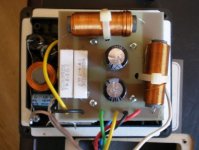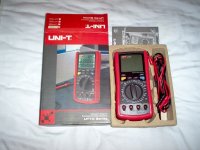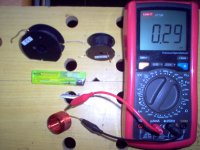No easy way....
Erik, if you don't know a useful answer, why do you answer at all?
...at the link below, the resonance method is probably the easiest.
Measuring inductance :: Electronic Measurements
FWIW, you can measure impedance with speaker workshop, ARTA, or even REW using a simple jig.
Last edited:
Erik, if you don't know a useful answer, why do you answer at all?
]
Perhaps if you'd read past "there's no easy way" - you'd have seen some of his useful suggestions.
Thump,
You can do this with Room EQ Wizard so I imagine just about any FR measurement tool could be adapted, kind of the way you were thinking.
REW seems to have this feature built in, so you don't have to manipulate the data yourself. Here's a link:
https://www.roomeqwizard.com/help/help_en-GB/html/impedancemeasurement.html
Best,
E
You can do this with Room EQ Wizard so I imagine just about any FR measurement tool could be adapted, kind of the way you were thinking.
REW seems to have this feature built in, so you don't have to manipulate the data yourself. Here's a link:
https://www.roomeqwizard.com/help/help_en-GB/html/impedancemeasurement.html
Best,
E
I appreciate all answers. I also would appreciate keeping personal feuds OUT OF MY THREAD.
I have REW. As well as a number of other measuring programs that I am more comfortable with in regards to what I suggested I might try. I do have a woofer that has a mostly flat impedance curve in the area where the inductors in question will most likely fall.
I have REW. As well as a number of other measuring programs that I am more comfortable with in regards to what I suggested I might try. I do have a woofer that has a mostly flat impedance curve in the area where the inductors in question will most likely fall.
FWIW, you can measure impedance with speaker workshop, ARTA, or even REW using a simple jig.
Care to elaborate?
I have REW. As well as a number of other measuring programs that I am more comfortable with in regards to what I suggested I might try.
So try it and report what you find. All depends on what you have patience for and what you are willing to learn.
Then try this, with the inductor in place of the speaker:
https://www.roomeqwizard.com/help/help_en-GB/html/impedancemeasurement.html#top
Then try it with a capacitor in place of the speaker.
Next put a known capacitor C in parallel with the inductor L, and measure the resonant frequency, Fr. Mind that there are factors of 1e-6 and 1e-3 that are likely to come into play.
L=1/(C*(2*pi*Fr)^2)
Sometimes it's pure intuition as to what value a coil has. If it's 3 layer ferrite or iron core, I would guess about 2mH. Inductance is the square of the number of turns.
If two layer, maybe 1mH. The fact is that ferrites and iron cores increase inductance about X4 over air coils. Along with any issues about distortion.
But since this is essentially science and measurement, you'd do best to splash out the bucks on a good meter with an inductance mH scale. Not cheap, around $100.
If two layer, maybe 1mH. The fact is that ferrites and iron cores increase inductance about X4 over air coils. Along with any issues about distortion.
But since this is essentially science and measurement, you'd do best to splash out the bucks on a good meter with an inductance mH scale. Not cheap, around $100.
Attachments
Last edited:
I spent $16 on this :
https://www.aliexpress.com/item/Min...32714252274.html?spm=2114.13010608.0.0.8PMu14
Measured a bunch of known inductors to within 5%
https://www.aliexpress.com/item/Min...32714252274.html?spm=2114.13010608.0.0.8PMu14
Measured a bunch of known inductors to within 5%
It's amazing what eBay can turn up in equipment from China. $16 is incredible for a good mH multimeter. 
After so many years in this game, I have a feel for what I am looking at.
The air-coil I am testing here is about 16 turns long by about 7 layers deep. All over, about 100 turns. You'd be right in estimating about 0.3mH.
After so many years in this game, I have a feel for what I am looking at.
The air-coil I am testing here is about 16 turns long by about 7 layers deep. All over, about 100 turns. You'd be right in estimating about 0.3mH.
Attachments
If you have a signal generator and an oscilloscope you can measure an inductor quite easily. Just build a resonant "tank" circuit from the inductor and a capacitor whose value is known. Feed in low frequency square waves, through a high value series resistor (R >> sqrt(L/C)) and measure the resonant frequency of the LC tank, by counting graticule divisions on the scope face.
You now know the capacitance C and the resonant frequency f, so you can calculate the inductance L. Duck soup!
I did this myself, just two days ago, and posted a write-up here on diyAudio: link
You now know the capacitance C and the resonant frequency f, so you can calculate the inductance L. Duck soup!
I did this myself, just two days ago, and posted a write-up here on diyAudio: link
I would venture a guess and say my method is accurate enough for my purposes. HolmImpulse was used for the FRD file creation, LIMP was used for the ZMA file creation and XSim was used to sim the crossover and find what the value is for the unknown inductor.
An externally hosted image should be here but it was not working when we last tested it.
An externally hosted image should be here but it was not working when we last tested it.
I just thought of something. This method only works if you already know the impedance curve of the driver you are using. If you can create a Zma file, why can't you measure the coil directly? 
Also, would help to measure and use the coil's DCR and use it in your sim.
Best,
E
Also, would help to measure and use the coil's DCR and use it in your sim.
Best,
E
Last edited:
I just thought of something. This method only works if you already know the impedance curve of the driver you are using. If you can create a Zma file, why can't you measure the coil directly?
Also, would help to measure and use the coil's DCR and use it in your sim.
Best,
E
Because I would have had to build the aforementioned jig and I already have a test mic for creating FRD files.
And to prove this method, here are two more I had to do.
**************************************************************************
An externally hosted image should be here but it was not working when we last tested it.
An externally hosted image should be here but it was not working when we last tested it.
**************************************************************************
An externally hosted image should be here but it was not working when we last tested it.
An externally hosted image should be here but it was not working when we last tested it.
- Status
- This old topic is closed. If you want to reopen this topic, contact a moderator using the "Report Post" button.
- Home
- Loudspeakers
- Multi-Way
- Unmarked Iron Core Inductors


